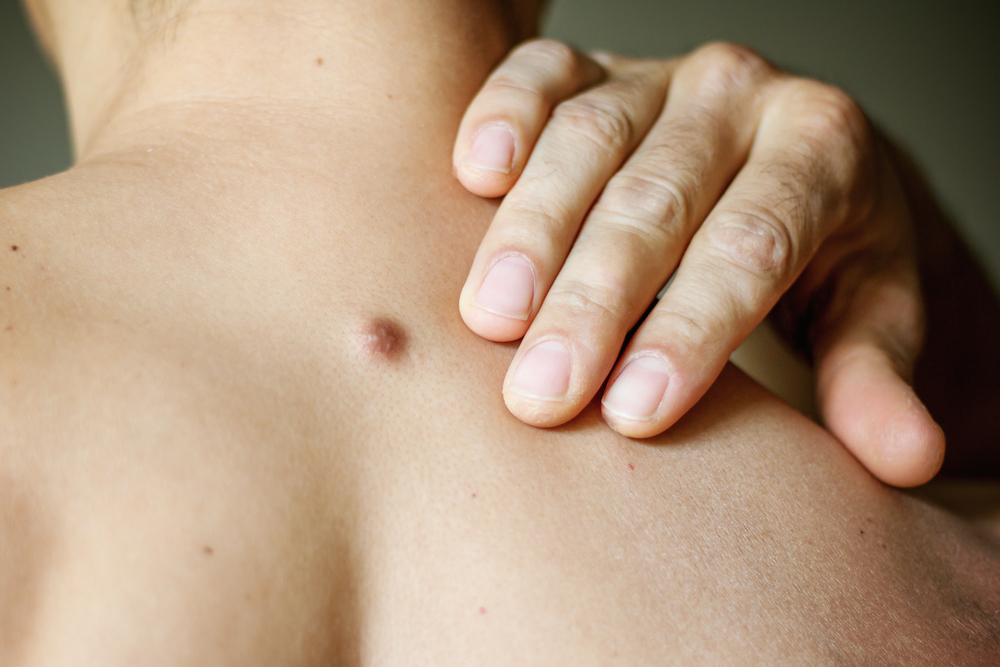Perfectly smooth skin is the mark of healthy skin and beauty, but it can be difficult to feel like your skin is healthy when your skin texture is marred by a bump or two. If you’ve run into a problematic cyst that is giving you some grief, you should know that you have a few treatment options available. At Dermatology Center of Acadiana in Lafayette, LA and Breaux Bridge, LA, our skilled dermatologists are fully prepared to walk you through what kind of cyst you have and the best type of cyst removal treatment for your unique situation.
Why Get Cyst Removal?
Most cysts are benign, which means there isn’t anything inherently wrong about them – they’re just kind of there, hanging out on your skin, and there is no reason to believe that they are malignant or cancerous. So, if these cysts are benign, why would you even bother to remove them? The truth of that matter is that while some cysts are small enough to ignore, others may be more problematic. The two main reasons to have a cyst remove include:
Discomfort
Some cysts can cause discomfort. If you think about it, a cyst puts pressure on your skin, which can stress the skin and set off your pain receptors, particularly if the cyst is inflamed or very large. This is usually true for new cysts or cysts that continue to grow.
Cysts are sometimes also in inconvenient locations. For example, cysts that form on the scalp can make it difficult to wash and brush your hair without discomfort. Similarly, some cysts form on sensitive patches of skin, such as on the eye, near the lips, and other areas of the body.
Confidence
Another common reason to have a cyst removed is for the sake of your confidence. Although cysts are smaller and flatter than warts, as well as usually being without pigment, some people feel like cysts on the skin draws attention – and that can certainly make your self-confidence plummet. Cysts aren’t something that can be covered up by makeup, either, so they can be difficult to hide.
Is It Dangerous to Leave a Cyst Untreated?
Yes and no. In general, benign cysts will stop growing at a point and simply become a new part of your skin surface, not unlike a skin tag. For that type of cyst, there isn’t any true damage that can happen. However, there are other types of cysts that continue to grow or become inflamed or infected over time, and that can certainly pose a danger to your skin.
For most cysts, the greatest risk of damage comes from the likelihood of scarring. While some cysts may resolve themselves on their own, others resolve themselves in a way that can leave permanent scars on the skin – including post-inflammatory hyperpigmentation, atrophic scarring, and other damage. Scarring on the skin is a significant risk, as it’s usually difficult to reverse scarring.
How Can You Avoid Potential Scarring?
Avoiding potential scarring is at the top of most people’s list, so one of the primary ways you can do this is by seeking treatment for a cyst as soon as you notice the cyst develop. Acting early and quickly is one of the best ways to avoid scarring as the result of a cyst. Another way to avoid potential scarring is to use the products prescribed by a dermatologist as directed, as many of these prescriptions are only effective when applied consistently.
What Types of Cysts Does a Dermatologist Treat?
It’s no exaggeration to say that there are hundreds of different cysts that can develop on the human body, so it’s a little hard to say which are the most common. At our clinic, we generally see patients for two types of cysts: acne cysts and epidermal inclusion cysts.
Acne Cysts
You’ve probably heard of cystic acne, right? This is acne that develops deep in the epidermis of the skin and erupts as a very large, often painful, pimple or pustule. Cystic acne includes nodules and sebaceous cysts that take root in the deeper skin tissues and make themselves very difficult to resolve, as it can be hard for medications to reach the bacteria of the acne for treatment. Acne cysts are one of the most common cysts that we treat, particularly for patients who continue to experience acne.
Epidermal Inclusion and Pilar Cysts
Epidermal inclusion and pilar cysts are two types of cysts that do not involve any bacteria or pustules. Epidermal inclusion cysts are bumps that form just under the epidermis, while pilar cysts are those that form deeper in the skin, usually near the hair follicles. Each of these types of cysts is typically benign, but they can be a great source of discomfort depending on their placement.
When Do You Need to Worry About Malignant Cysts?
Only a very small portion of cysts turn out to be cancerous, but that doesn’t mean you shouldn’t be aware of signs to look out for. Truthfully, the only way to determine if any given cyst is malignant is to perform a small biopsy and test the cells of the cyst for any cancerous abnormalities. Most cysts are benign after testing, too.
But what can you, as a patient, look out for to see if a cyst is suspicious? For one thing, rapid growth, redness and inflammation, and ongoing infections are all signs that you should get your cyst looked ed at. You should also pay attention to whether or not the cyst has a symmetrical shape, as asymmetric cysts are usually at higher risk of being cancerous.
What Causes Cysts to Form?
Cysts can form for all kinds of reasons. For example, acne cysts form from a combination of bacteria and blockages of the pores. Other reasons cysts might form can be anything from genetics to defective cells that are regenerating incorrectly. Cysts can form as the result of an injury, meaning they can be another type of scarring, as well as from infections or parasites. Essentially, cysts can form at any time for any reason.
What Are Common Cyst Removal and Treatment Methods?
If cysts are so common and if they can form with very little encouragement, how can you treat or remove them effectively? Fortunately, most removal and treatment methods are designed to either permanently treat the cyst or manage the cyst so that it doesn’t get worse over time. There are a few common removal and treatment methods you should be aware of, including:
Antibiotics and Steroids
Antibiotics and steroids are ideal treatment methods for cysts that develop as the result of infection, parasites, or other causes that aren’t related to normal body function. Antibiotics and steroids can be administered topically, orally, or through direct injections, depending on the type of cyst being treated.
Prescription Creams
Prescription creams, such as isotretinoin, are typically prescribed as long-term solutions for recurring cysts, including for the treatment of acne cysts. Prescription creams are applied topically at home for several days or weeks, either until the cyst is resolved or other treatments are necessary. Prescription creams like isotretinoin are frequently powerful enough to manage cyst development for long periods of time – sometimes these creams are even permanent solutions.
Draining
It may be the case that your cyst needs to be drained to be fully treated. There are several different types of cysts that need to be drained, particularly those filled with fluid, bacteria, and other substances that are causing additional inflammation for the skin. Draining is usually done for cysts that are in locations where creams can’t be easily used, or for cysts that have not responded to more conservative approaches.
Cyst draining is an in-office appointment that will be performed by your dermatologist and will typically take about 20 minutes to complete. For patient comfort, we usually apply a topical numbing cream before draining.
Surgical Removal
Surgical removal is usually only done in two cases. The first is when benign cysts have not responded to other treatments, or because the cyst location is causing too much discomfort. The second is for malignant cysts, which must be removed at the root to prevent the further spread of cancerous growth. Surgical removal is typically the last-resort option for cyst treatment and removal.
However, it should be noted that surgical removal can sometimes be performed for purely cosmetic purposes. This is particularly true for patients who have large benign cysts and would like to remove the bump from their skin for superficial reasons.
What Is Cyst Removal Surgery Like?
Cyst removal surgery is generally a fast procedure that will take about one to two to complete. Some patients receive surgical removal under a local anesthetic, sometimes in our office on an out-patient basis. Other patients may require surgical removal in a hospital setting and with the use of general anesthesia, particularly if the cyst is larger or located in a less convenient location.
Removal surgery involves making an incision on or near the cyst to drain the cyst or remove it entirely. This is a surgery that usually involves stitches or sutures, as well as a small amount of recovery time.
How Do You Know Which Cyst Removal Method Is Best for You?
Figuring out the type of cyst treatment or removal method best for your particular needs is something only you and your dermatologist can determine. However, it should be noted that most dermatologists favor a more conservative approach at first, which means trying the non-invasive treatments and seeing if your cyst responds. For many patients, this means starting with a prescription cream, moving on to steroids, trying draining, and finally surgery, if all else has failed.
Are You a Good Cyst Removal Candidate?
If you are an adult with a cyst, you are likely a good candidate for removal treatments. All cysts can be treated to some degree and most are eligible for removal, particularly if they have not responded to other treatments. Good candidates for cyst treatment and removal includes anyone who is experiencing pain, discomfort, infections, inflammation, or loss of confidence as a result of a cyst.
Restore Your Confidence With Cyst Removal Treatments!
When it comes to treating a cyst, you have plenty of options that should be considered. Whether your treatment approach is conservative or aggressive, you can rest assured knowing that there is likely a treatment option that will work for you. If you’re ready to restore your confidence with cyst removal treatments, please contact the Dermatology Center of Acadiana in Lafayette, LA and Breaux Bridge, LA to schedule your consultation today!

